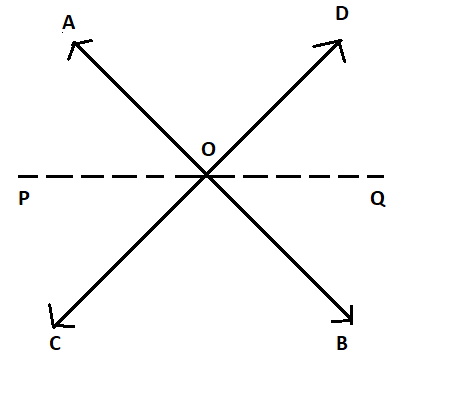
If two straight lines intersect each other, prove that the ray opposite the bisector of one of the angles thus formed bisect the vertically opposite angle.
Answer
607.2k+ views
Hint:In this type of question first we draw the figure with given information by letting the rays name. Then, using properties of geometry angles, vertically opposite angle and angle bisector proving the ray opposite the bisector of one of the angles thus formed bisect the vertically opposite angle.
Complete step-by-step answer:
Given: Two straight lines intersect each other.
Let AB and CD are straight lines which intersect at point O. OP is the bisector of $\angle {\text{AOC}}$.
Now, extend the OP to Q.

We have to prove OQ is the bisector of $\angle {\text{BOD}}$.
We know, AB, CD and PQ are the straight lines which intersect at point O.
Now,
$
\Rightarrow \angle {\text{AOP = }}\angle {\text{BOQ (vertically opposite angles) eq}}{\text{.1}} \\
\Rightarrow \angle {\text{COP = }}\angle {\text{DOQ (vertically opposite angles) eq}}{\text{.2 }} \\
\Rightarrow \angle {\text{AOP = }}\angle {\text{COP (OP is the bisector of }}\angle {\text{AOC) eq}}{\text{.3 }} \\
$
From eq.1, eq.2 and eq.3, we get
$\angle {\text{BOQ = }}\angle {\text{DOQ}}$
Therefore, the ray opposite to the bisector of one of the angles thus formed bisects the vertically opposite angle.
Hence proved.
Note: Whenever you get this type of question the key concept to solve this is to learn the concept of angle bisector which is a line or line segment that divides an angle into two equal parts. And the concept of vertically opposite angles which states that in a pair of intersecting lines the vertically opposite angles are equal.
Complete step-by-step answer:
Given: Two straight lines intersect each other.
Let AB and CD are straight lines which intersect at point O. OP is the bisector of $\angle {\text{AOC}}$.
Now, extend the OP to Q.

We have to prove OQ is the bisector of $\angle {\text{BOD}}$.
We know, AB, CD and PQ are the straight lines which intersect at point O.
Now,
$
\Rightarrow \angle {\text{AOP = }}\angle {\text{BOQ (vertically opposite angles) eq}}{\text{.1}} \\
\Rightarrow \angle {\text{COP = }}\angle {\text{DOQ (vertically opposite angles) eq}}{\text{.2 }} \\
\Rightarrow \angle {\text{AOP = }}\angle {\text{COP (OP is the bisector of }}\angle {\text{AOC) eq}}{\text{.3 }} \\
$
From eq.1, eq.2 and eq.3, we get
$\angle {\text{BOQ = }}\angle {\text{DOQ}}$
Therefore, the ray opposite to the bisector of one of the angles thus formed bisects the vertically opposite angle.
Hence proved.
Note: Whenever you get this type of question the key concept to solve this is to learn the concept of angle bisector which is a line or line segment that divides an angle into two equal parts. And the concept of vertically opposite angles which states that in a pair of intersecting lines the vertically opposite angles are equal.
Recently Updated Pages
Two men on either side of the cliff 90m height observe class 10 maths CBSE

Cutting of the Chinese melon means A The business and class 10 social science CBSE

Show an aquatic food chain using the following organisms class 10 biology CBSE

How is gypsum formed class 10 chemistry CBSE

If the line 3x + 4y 24 0 intersects the xaxis at t-class-10-maths-CBSE

Sugar present in DNA is A Heptose B Hexone C Tetrose class 10 biology CBSE

Trending doubts
Why is there a time difference of about 5 hours between class 10 social science CBSE

What is the median of the first 10 natural numbers class 10 maths CBSE

Indias first jute mill was established in 1854 in A class 10 social science CBSE

Indias first jute mill was established in 1854 in A class 10 social science CBSE

Write a letter to the principal requesting him to grant class 10 english CBSE

The Equation xxx + 2 is Satisfied when x is Equal to Class 10 Maths




